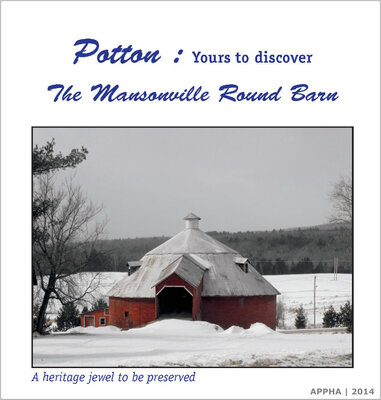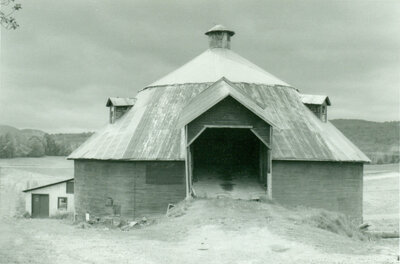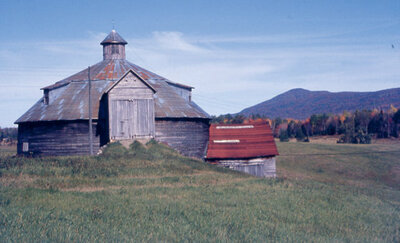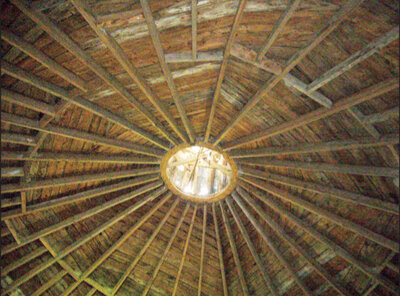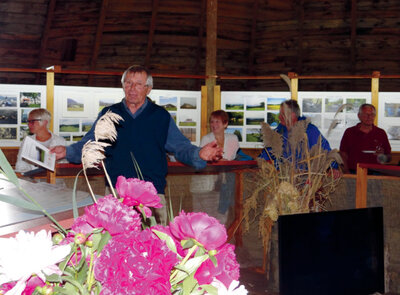The Mansonville Round Barn
Mansonville has the priceless asset of having a one hundred year old round barn right in the centre of the village.
According to registry office records, it was built in 1911–1912 for Robert J. Jersey.
Since then, it has been owned by several dairy farmers including Alfred Marcoux and his son Lionel. When he retired from farming in 1990, Charles Eugène Labbé sold the property to the Giroux family.
The Round Barn Concept
This style of barn displays a impressive architecture characterized by its circular shape. This building style, spectacular and unique to the Eastern Townships, was developed by the Shakers, a religious sect from New England who regarded the circle as a symbol of perfection that, according to a popular belief; prevented the Devil from hiding in the corners!
Beyond symbolism and myth, a round barn is functional in its design: in our barn, about fifty cows could be housed in stalls around the perimeter of the ground floor, with the calves being held in smaller pens. This layout, which is still intact, allowed the farmer to feed and water animals efficiently.
Hay, stored in the loft on the floor above the stable, was fed through a central shoot, and distributed to the circle of animals in stanchions below. Manure was removed by a mechanical rake, called a stable cleaner, located within the circular gutter behind the stalls.
Above the hayloft, is the third floor, accessible by an exterior ramp, called a barn bridge. Hay wagons drew hay to this floor from which the hay was off-loaded and stored in the loft below.
Outside of Mansonville, the Township of Potton had three other round barns which have all disappeared.
In Highwater, Bill Gendron built one that resisted the 1913 hurricane as well as the November 1927 flood that devastated the valley and parts of New England. He lost several cows by drowning.
The two other round barns were located along Route 243. One, owned by Leon Eldridge while Joseph Messier's was at the corner of Traver Road.
A Heritage Jewel
The Mansonville barn, a heritage jewel, attracts the visitors’ curiosity because there are only seven left in the Eastern Townships, all built between 1901 and 1915. Its interior architecture is exceptional.
Our barn measures about 70 feet (21 m); its walls are 20 feet (6 m) high; and, the overall height to the cupola reaches about 50 feet (15 m).
Inside the barn, the great space of the upper floor where one can admire the roof supported by about one hundred wooden beams converging towards the ventilation shaft is most impressive, reminding one of the ribbed vaults of ancient cathedrals.
The End of an Era
The failure of the round barn to gain in popularity lay, no doubt, in their unique design. It was cheaper, faster and easier to erect a four-sided building than to build these spectacular round ones. Its introduction came rather late in our history and it occurred at a time when our rural population was beginning to decline, due to emigration to urban areas. Large farms close to urban areas were more competitive. Train service, essential for the fast delivery of milk to the rural dairies, ceased operation in the North Missisquoi Valley in 1936.
The Future of our Round Barn
The Round Barn in Mansonville is a unique part of Potton‘s built heritage. It was recognized as an historic monument by resolution of the Municipal Council on July 7, 2009. Its renovation was entrusted to the Groupe bénévole municipal de Potton in 2011. In a 1982 study by the specialist Mr. Yvon Provost, the site was qualified as “...exceptional and one of the best examples of a round stable-barn”. Unfortunately, as for all old abandoned buildings, it is showing its age and its structural condition is now a worry.
Aware of its mission to protect and to promote our built heritage, Potton Heritage Association has given top priority to conserving the Round Barn. Our Association has funded the cost of preliminary research into its stabilization and preservation. Procedures to refurbish and preserve the Barn to make it accessible by the public, are on-going.
The long term objective is to create a showcase for the promotion of the many facets of Potton’s rich heritage. This renovation project will not only benefit the people of Potton, but also our neighbouring municipalities. Since tourism is one of the keys to our economy, a regional centre of attraction is essential. The Mansonville round barn will fit the bill!
Our round barn is a unique witness to the agricultural history of Potton, and the time when pioneers and their descendants worked to establish homes and farms here. It was they who cultivated the land and shaped the landscapes that we all now cherish and still strive to preserve. We value this rich existing resource, not only as a testament of sorts to the lives of the Jersey, Marcoux, Labbé and Giroux families, but to all of those proud to say they were born here and those who choose to make Potton their home.
To preserve our Round Barn for the future is to respect its value as a symbol of social continuity.
Production team
Text: Gérard Leduc and Jean-Louis Bertrand
Revision: Peter Downman & Sandra Jewett
Photography: Gérard Leduc
Printed edition © 2012
Web edition: Serge Normand, 2024
Web edition revision: Jacqueline Robitaille, 2025
